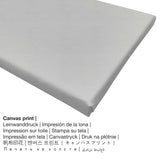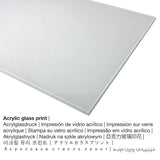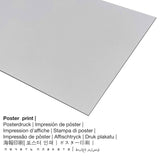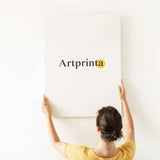James Jacques Joseph Tissot, 1862 - The return of the prodigal son - fine art print
Taxes incluses. Frais de port calculés au paiement.
In-depth art product infos
This more than 150 year-old masterpiece was created by the master James Jacques Joseph Tissot in 1862. The masterpiece was painted with the size: Height: 115,5 cm, Width: 206 cm. Oil, Canvas (material) was used by the painter as the medium of the painting. The original masterpiece has the following text as inscrption: Date and signature - Bottom left: "James Tissot 1862". What is more, this piece of art forms part of the Petit Palais - Musée des Beaux-arts de la Ville de Paris's digital art collection. With courtesy of: Petit Palais Paris (licensed: public domain).Creditline of the artwork: . In addition to that, the alignment is landscape with an image ratio of 16 : 9, which implies that the length is 78% longer than the width.
Select your preferred item material
For every fine art print we offer different materials and sizes. Choose among the following product options now to match your preferences in size and material:
- Metal print (aluminium dibond): Aluminium Dibond prints are prints on metal with an outstanding effect of depth. A non-reflective surface structure creates a fashionable look. The bright parts of the work of art shimmer with a silk gloss, however without any glare.
- Poster print (canvas material): A poster print is a printed cotton canvas with a granular texture on the surface. It is best suited for placing the fine art print using a personal frame. Please keep in mind, that depending on the size of the canvas poster print we add a white margin 2-6cm round about the print motif, which facilitates the framing with a custom frame.
- The canvas print: A canvas direct print is a printed canvas stretched on a wooden frame. A canvas of your favorite masterpiece will give you the unique opportunity of transforming your fine art print into a large artwork. Canvas prints are relatively low in weight. This means, it is quite simple to hang up the Canvas print without the support of additional wall-mounts. Therefore, a canvas print is suitable for any type of wall.
- Glossy acrylic glass print (with real glass coating): An acrylic glass print, which is often denoted as a UV print on plexiglass, will change the original work of art into beautiful décor. Your favorite artwork is being custom-made with the help of state-of-the-art UV direct print technology. This creates deep, vivid color shades. With a glossy acrylic glass art print contrasts as well as painting details will be identifiable with the help of the delicate gradation.
Important information: We try whatever we can to depict our products with as many details as it is possible and to display them visually on the respective product detail pages. Although, the pigments of the printing material and the printing might vary marginally from the presentation on your device's monitor. Depending on the screen settings and the condition of the surface, not all color pigments are printed one hundret percent realistically. Bearing in mind that all our art prints are printed and processed manually, there may also be minor differences in the exact position and the size of the motif.
The product
| Print categorization: | fine art reproduction |
| Method of reproduction: | digital reproduction |
| Manufaturing technique: | UV direct print |
| Manufacturing: | German production |
| Stock type: | on demand production |
| Proposed product use: | wall decoration, home design |
| Alignment: | landscape alignment |
| Image aspect ratio: | 16 : 9 length to width |
| Aspect ratio meaning: | the length is 78% longer than the width |
| Available choices: | canvas print, acrylic glass print (with real glass coating), poster print (canvas paper), metal print (aluminium dibond) |
| Canvas print (canvas on stretcher frame): | 90x50cm - 35x20", 180x100cm - 71x39" |
| Acrylic glass print (with real glass coating) size variants: | 90x50cm - 35x20", 180x100cm - 71x39" |
| Poster print (canvas paper) sizes: | 90x50cm - 35x20" |
| Aluminium dibond print (aluminium material) variants: | 90x50cm - 35x20" |
| Picture frame: | without frame |
Background information about the original artpiece
| Name of the painting: | "The return of the prodigal son" |
| Classification: | painting |
| Broad category: | modern art |
| Artwork century: | 19th century |
| Created in: | 1862 |
| Artwork age: | over 150 years old |
| Artwork original medium: | Oil, Canvas (material) |
| Original artwork dimensions: | Height: 115,5 cm, Width: 206 cm |
| Signature on artpiece: | Date and signature - Bottom left: "James Tissot 1862" |
| Museum: | Petit Palais - Musée des Beaux-arts de la Ville de Paris |
| Place of museum: | Paris, France |
| Web URL of Museum: | Petit Palais - Musée des Beaux-arts de la Ville de Paris |
| Artwork license: | public domain |
| Courtesy of: | Petit Palais Paris |
About the artist
| Name: | James Jacques Joseph Tissot |
| Jobs of the artist: | painter |
| Artist category: | modern artist |
| Age at death: | 66 years |
| Birth year: | 1836 |
| Birthplace: | Nantes |
| Died: | 1902 |
| Deceased in (place): | Chenecey-Buillon |
© Copyright of - Artprinta.com
Additional artwork information by the museum's website (© Copyright - Petit Palais - Musée des Beaux-arts de la Ville de Paris - www.petitpalais.paris.fr)
The parable of the prodigal son is taken from the Gospel according to Luke. A son who had left the family home with his inheritance quickly spent his money and soon found himself in misery. He later returned imploring kneeling pardon of his father who happily accepted the return of his child. Father welcomes her child in the yard of his rich remains under the curious gaze of residents. Behind a fortified gate are staged roofs of the city and the foothills of a Gothic cathedral. Tissot features the return of the prodigal son in a medieval setting. Its neo-Flemish style recalls the way the painter Henri Leys Antwerp (1815-1869).
This painting was exhibited at the Salon of 1863 along with its counterpart, "The start of the prodigal son", also kept at the Petit Palais. The harsh criticisms that are brought to him because of his neo-Gothic inspiration have contributed to the evolution of his work to the painting of modern life. Tissot will resume later this theme of the prodigal son, but locating the scenes in the nineteenth century.
Biblical scene, the prodigal son, the New Testament Scene














